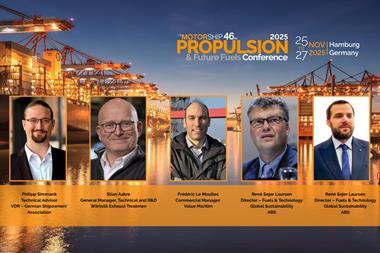At the Propulsion and Future Fuels event in Hamburg, two complementary perspectives on maritime fuel cells were presented

At the Propulsion and Future Fuels event in Hamburg, two complementary perspectives on maritime fuel cells were presented: one centred on safety and regulatory readiness, the other on deployment pathways and practical early use cases. Together they gave a clear picture of how fuel cells—particularly PEM and solid oxide systems—are moving from concept to scalable application, even as LNG and biofuels continue to dominate the near-term fuel landscape.
Dr Thomas Bayer of Lloyd’s Register emphasised that fuel cells are becoming a credible option for maritime power, offering higher efficiency, low noise and the potential for very low or even zero emissions depending on the fuel used. From a class perspective, however, safety remains the central concern. Hydrogen, the primary fuel for PEM systems, is challenging due to its propensity to leak, its wide flammability range and the risks of embrittlement. Bayer explained that the current IMO interim guidelines treat the fuel cell module as a “dangerous black box” that must be isolated through the design of the fuel cell space, and he outlined LR’s own rules, developed to complement these guidelines. The main safeguards revolve around containment, ventilation and dilution, gas detection and the removal of ignition sources.
Two approaches to fuel cell space design are emerging. The first is the ESD-protected arrangement, where any gas leakage leads to emergency shutdown of the entire space. This is robust but compromises power availability. The second, increasingly favoured by industry, is the gas safe design, in which a secondary enclosure around the fuel-containing components prevents leakage into the space. This approach allows only the affected module to shut down, improving overall power reliability and making the concept more attractive for retrofits. Bayer noted that integration challenges remain significant, particularly for hydrogen piping and secondary boundaries in existing machinery spaces, but operational experience and updated rules are emerging quickly, including guidance on onboard hydrogen generation and reforming. Collaboration with fuel cell manufacturers—many of whom originate from the automotive sector—is essential, especially in understanding durability and long-term performance. He concluded that the scale of installations is increasing rapidly, with systems above 6 MW already being realised, signalling that fuel cells are no longer confined to auxiliary roles.
Where Bayer focused on safety and regulation, Sami Kanerva, global product manager for fuel cell solutions at ABB, shifted attention to how fuel cells will actually be used in the fleet over the coming decade. He began with a dose of realism: despite strong interest in hydrogen, LNG, biofuels and other natural-gas-based solutions will dominate for some time. The IMO climate regime reinforces this trajectory rather than derailing it. Hydrogen will nonetheless play a growing role, but adoption will begin with small vessels and niche operators before scaling to larger ship types. In parallel, battery technology and fast charging continue to improve, though power-grid bottlenecks persist—an issue that directly links to fuel cell deployment strategies.
Kanerva identified three drivers of maritime interest in fuel cells: the ability of PEM systems to run on green hydrogen; the high efficiency of both PEM and solid oxide fuel cells; and the strong compatibility of solid oxide systems with LNG and potential future carbon capture. These technologies are increasingly seen as complementary rather than competing: PEM aligned with hydrogen and methanol reforming, and solid oxide aligned with LNG and natural gas.
He described three practical use cases. The first is the hybrid electric or hydrogen-electric vessel, where fuel cells act as a range extender for battery systems. Vessels fall on a spectrum from fully electric to fully hydrogen-powered, with most real designs combining the two and optimising total cost of ownership based on fuel price, port electricity, storage and battery replacement. The second use case is replacing or supplementing auxiliary engines. Fuel cells can run alongside shore power or act as the main power source in ports lacking adequate grid capacity, delivering moderate but meaningful emission reductions. The third is shore-side installation: ports can install fuel cells—either PEM using local green hydrogen or solid oxide using abundant natural gas—to supply peak electrical demand and enable zero-emission operations for vessels that do not carry fuel cells or hydrogen storage on board.
Kanerva stressed that fuel choice determines fuel cell choice, and nearly all applications will be hybrid configurations combining batteries, fuel cells and sometimes combustion engines. Fuel cells’ modularity allows gradual scaling, early deployment and phased decarbonisation.
Taken together, both speakers presented a maturing technology. Bayer showed that safety frameworks are now robust enough to support growing installations, while Kanerva demonstrated that viable commercial and operational niches are emerging. Fuel cells may not replace LNG or biofuels immediately, but they are establishing themselves as an essential component of the long-term, multi-fuel pathway to maritime decarbonisation.








